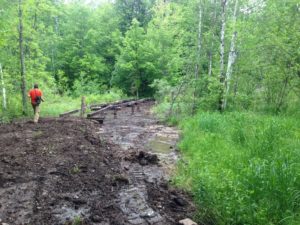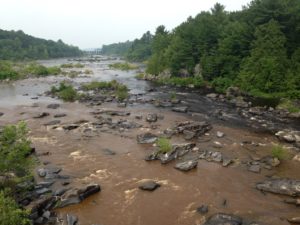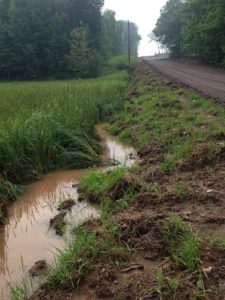An article from WWA’s Words From The Wardens.
This article originally appeared in Wisconsin Waterfowl Association’s June 2020 eNewsletter. Photos courtesy Warden Schreiber.
 By Investigative Warden John Schreiber and Wetland Compliance Team Coordinator Emily Pedersen
By Investigative Warden John Schreiber and Wetland Compliance Team Coordinator Emily Pedersen
Ring, ring, ring; or nowadays, ding!
The warden gets a text or call from a concerned citizen or the DNR Hotline, reporting a possible wetland violation, or wardens observe wetland and waterway violations while afield checking recreational user compliance.
Wetlands provide an ample resource in our state, offering us clean water, aquatic and terrestrial habitat, and flood protection. Here in Wisconsin, we are fortunate enough to have vast wetland areas which enhance waterfowl habitat, promoting waterfowl feeding, nesting, viewing and hunting opportunities.
WETLANDS WORK IN THE FIELD

Common fill being placed in a landowner’s wetland area in their woods for travel on their property. The DNR works with the landowner to implement an alternative to fill by using a permitted bridge.
Wardens work hard afield to enforce wetland laws where individuals or commercial entities are completing un-permitted activity, which affects wetland functions and values. Wardens contact responsible parties involved in wetland violations to determine the scope of the work completed, whether a permit was issued, or if any other regulatory program provided insight into the project.
While the Natural Resources Conservation Service provides guidance and assistance programs to landowners, it’s important to know that DNR regulates wetland fill activity under Wis. Stats. 281.36. If you are considering a project in wetlands for habitat enhancement, agricultural, residential or other purposes, we encourage you to contact DNR up front to review your proposed project and discuss ideas that protect wetlands and meet your goals.
Wetland violations frequently result from practices such as ditching, installation of drain tile, mechanized land clearing, and un-permitted fill resulting from both residential and commercial projects. The department regulates discharge of fill to wetlands.
DNR TEAM TO HELP WETLANDS
Wardens work directly with the DNR’s Waterway and Wetland Compliance Team to resolve areas of noncompliance. The vast majority of wetland fill complaints received by the DNR are resolved through voluntary compliance, which typically includes either after-the-fact permitting or restoration.
The DNR has citation authority for violations of s. 281.36, Wis. Stats. Citations can be issued for failing to obtain a permit or violating conditions of a DNR-issued permit. These citations can range from $502.50 to $1597.50 and may include a restoration order if appropriate.
The department is authorized to seek injunctive or other appropriate relief for violations of wetland regulations, including forfeitures of up to $10,000 for each violation; each day is a separate offense. The Department has the ability to refer severe or unresolved violations to the Department of Justice for resolution. The Department uses a stepped enforcement process through the Environmental Enforcement program to achieve compliance and restoration at the lowest level of enforcement appropriate for the circumstances.
It is often observed that most wetland related violations didn’t start as a big planned project, but expanded as the project went on.
Through the permitting process with the DNR, wetland projects can be done legally by keeping best management practices in mind. Permitting processes allow the DNR to assist with review of the wetland area to minimize impacts, identify wetland boundaries, assess soil types, and establish monitoring to minimize invasive plant growth and maximize natural plant growth.
PARTNERSHIPS VITAL FOR WETLANDS’ FUTURE
Partnerships with community organizations and sportsman/women groups are vital to the protection and enhancement of Wisconsin wetlands. Organizations like the Wisconsin Waterfowl Association can be a pillar and advocate for legal and ethical wetland protection and enhancement through their restoration and enhancement projects. Wisconsin waterfowlers all over the state help wetland habitat for ducks and related species through completing permitted enhancement projects like scrapes and native plantings, and most importantly, preservation of existing wetlands.
If you are wondering if your wetland related activity needs a permit, contact our Waterway and Wetland Information Line at (608) 267-3125 or via email at DNRWMSPublicInquiry@wisconsin.gov. Also, check our website for more information regarding wetland functions, permits, and exemptions at the following link: https://dnr.wi.gov/topic/wetlands/.


